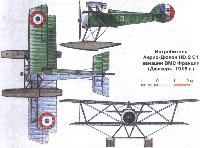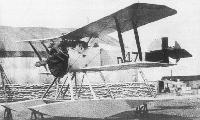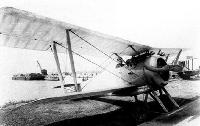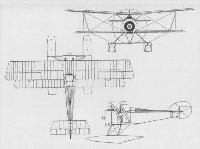А.Шепс Самолеты Первой мировой войны. Страны Антанты
Анрио-Дюпон НD.2 1916 г.
Сразу же после создания истребителя HD.1 фирма построила его поплавковый вариант HD.2 для замены устаревшего Сопвич "Бэби". Поплавки однореданные, деревянные, крепились восьмью деревянными стойками. Вооружение было усилено - стояло два синхронных 7,71-мм пулемета "Виккерс".
Небольшое количество машин, построенных фирмой, использовались в основном на Средиземноморском театре военных действий.
Следует отметить, что из-за значительного аэродинамического сопротивления поплавков ухудшалась управляемость. Поэтому была увеличена площадь руля поворота. Двигатель более мощный, "Рон" (130л. с.) или Клерже 9В.
Один из HD.2 был переставлен на колесное шасси, им был вооружен линкор "Париж". Истребитель взлетал с деревянной палубы, оборудованной на башне орудий главного калибра. 10 штук, в том числе и на колесном шасси, были поставлены американскому флоту, базировавшемуся во Франции. После войны их перевезли в США, там переделали под колесное шасси и использовали в качестве учебно-тренировочных машин.
Показатель HD.2 C1 1916г.
Размеры, м:
длина 7,21(5,85?)
размах крыльев 8,68
высота 2,9
Площадь крыла, м2 18,0
Сухой вес, кг 395
Взлетный вес, кг 600
Скорость максимальная, км/ч 183
Время набора высоты
2000м, мин 6,4
Потолок практический, м 6300
Двигатель: "Рон"
мощность, л. с. 110
Вооружение 2 пулемета
Показать полностью
J.Davilla, A.Soltan French Aircraft of the First World War (Flying Machines)
Hanriot HD.2
The HD.2 was a seaplane version of the HD.1 fighter. The aircraft was essentially an HD.1 with a pair of floats suspended beneath the fuselage. A fin beneath the tail of the fuselage was intended to balance the floats. At least one aircraft was tested using a single float, but this arrangement was found to be unsatisfactory and further development was abandoned. The HD.2s usually had the more powerful 130-hp Clerget 9Bs instead of the 120-hp Le Rhone 9Jbs.
To improve stability on the water, the third HD.2 had elongated floats and the fin and rudder were enlarged over the basic HD.1. The HD.2s were armed with two Vickers machine guns and were based at Dunkerque to supply protection for the flying boats based there. A total of 17 HD.2s were delivered from January to October 1917.
The Aviation Maritime also used HD.2s with a conventional wheel undercarriage. These planes may have carried the designation HD.2 C. Examples of these aircraft were flown off a turret of the ship Paris. Enseigne de Vaisseau Paul Teste practiced takeoffs and landings from a platform similar to the one fitted to the Paris, but located on land at the Saint Raphael naval base. The aircraft used had a 120-hp Le Rhone 9Jb in place of the Clerget engine. After 20 practice flights, the first actual takeoff took place on 26 October 1918 when an HD.2 was successfully launched from the Paris and landed at Toulon. A second attempt on 9 November 1918 was unsuccessful because the Paris failed to generate adequate wind over the deck, and the HD.2 crashed over the forward deck, fortunately without injury to the pilot. Later, pilots from C 10 were trained to land on a ship's deck by using a steep approach to the ship and had a crude arrestor gear fitted to the HD.2. HD.2s were also flown from the carrier Bearn in the 1920s; at that time construction had not been completed on the carrier and it was, in fact, merely a flight deck placed atop the uncompleted battleship.
Approximately 30 HD.2s were sent to the Saint Raphael naval aviation center at the end of 1918. Here, the HD.2s were converted from floats to wheel undercarriages and were assigned to AC 1 (escadrille de chasse) formed in 1919. The Hanriots served in front-line service until 1925 when they were replaced by Gourdou-Leseurre 22s. They subsequently served as trainers from 1925 until 1928. The temperamental Clerget rotary engines ensured that the HD.2s were not assigned to the Bearn; the Clergets were not reliable enough for the demands placed on them by carrier takeoffs and landings.
United States
The U.S. naval aviation service decided to purchase the HD.2 floatplane for use at its Dunkerque naval air station. Aircraft operating from the Dunkerque station had suffered heavy losses due to German fighters, and it was hoped that the Hanriots would provide the Donnet-Denhaut flying boats that were operated from the station with a measure of safely. Twenty-six HD.2s were purchased from the French government for the U.S. Navy. Serial numbers were: 211-220, 231-240, 244, 245, 249, 250, 252, and 258.
The HD.2s accompanied the Donnet-Denhaut flying boats on almost 500 patrols. However, no German aircraft were encountered during any of these missions.
After the war, ten of the Hanriots (serial A 5620 to A 5629) were sent back to the United States. The floats were removed and replaced with wheels, flotation bags, and hydrovanes. Modifications were also made to the rudder and a heavier skid was fitted. They were initially used as fighter trainers with two forward-firing 0.303 machine guns. The modified HD.2s were subsequently flown from ramps mounted on turrets of battleships and A-5624 was flown from the cruiser U.S.S. Mississippi in August 1919. Four HD.2 landplanes were used by the Second Ship Plane Unit from May to August 1919.
HD.2 Single-Seat Floatplane Fighter with 130-hp Clerget 9B
Span 8.70 m; length 7.00 m, height 3.10 in; wing area 18.20 sq. tn
Empty weight 495 kg; loaded weight 723 kg
Maximum speed: 182 km/h; climb to 2,000 m in 6 minutes 30 seconds; ceiling 4,800 m; range 300 km
Armament: two 7.7-mm Vickers machine guns
HD.2 (C) Single-Seat Ship-Based Fighter with 130-hp Clerget 9B
Span 8.70 m; length 5.94 m, height 2.59 m; wing area 18.90 sq. m Maximum speed: 180 km/h
Armament: two 7.7-mm Vickers machine guns
Hanriot HD.12
Although this aircraft did not actually fly until 1921 it falls within the scope of this present work as it represents the last development of that classic First World War design, the Hanriot HD.1. The HD.12 was similar to the HD.1 but with a more powerful engine. It is unclear if the HD.12 was intended for the C1 category (single-seat fighter) or was always planned as a shipboard naval fighter. In any event, the HD.12 was not selected by the Aviation Militaire for production, but it was tested by the Aviation Maritime for possible shipboard use.
The HD.2 and HD.4 had been flown from the turrets of naval vessels. This procedure required that crewmen on the ships literally hold the aircraft down while the pilot brought the engine to maximum power. At a signal from the pilot the personnel would release the aircraft. The HD.12 acquired by the Aviation Maritime was intended to facilitate this arrangement by making takeoff release simpler and more reliable. The primary improvement over the HD.1 was the fact that its more powerful engine meant that the HD.12 required a shorter takeoff run.
The aircraft had a primitive arrestor gear which could be released by the pilot after the engine had been run up. With this new arrangement, the plane could become airborne within only six meters. The aircraft was powered by a 170-hp Le Rhone 9R. Armament was planned to be two synchronized 7.7-mm Vickers machine guns. Other changes from the HD.1 included the deletion of the ailerons from the top wing, being instead fitted to the lower wing. The ailerons were enlarged from those used on the HD.1 and the wings were of equal span.
Initial testing was accomplished at Villacoublay and subsequent testing was performed at the naval base at Saint-Raphael. Two HD.12s were used to train pilots and were flown from the platform mounted on the Bapaume. Although the plane was successful, further development was abandoned in favor of the more modern HD.27.
HD.12 Single-Seat Shipboard Fighter with 170-hp Le Rhone 9R
Span 8.70 m; length 5.94 m; height 2.59 m; wing area 19.00 sq. m
Empty weight 480 kg; loaded weight 690 kg
Maximum speed: 190 km/h at sea level
Armament: two synchronized 7.7-mm Vickers machine guns
At least two built
Показать полностью
G.Swanborough, P.Bowers United States Navy Aircraft Since 1911 (Putnam)
HANRIOT HD-1, 2
The Navy acquired 26 French Hanriot HD-2 seaplane fighters for use in Europe during World War 1. Except for the 130 hp Clerget engine and a large rudder, these were seaplane versions of the well-known Hanriot HD-1 (for Hanriot-Dupont) landplane. After the Armistice, 10 HD-2s were shipped to the US Naval Aircraft Factory for reconditioning and conversion to HD-1 landplanes, and were assigned serials A5620-A5629. Fitted with flotation bags and hydrovanes ahead of the wheel undercarriage, they were flown from battleships. Span, 28 ft 6 in; length, 19 ft 8 in; gross weight, 1,521Ib; max speed, 115 mph.
Показать полностью
W.Green, G.Swanborough The Complete Book of Fighters
HANRIOT HD.2 France
At the end of 1917, a derivative of the HD.1 intended for use by France’s Aviation maritime as a single-seat fighter floatplane was tested as the HD.2. Possessing an airframe essentially similar to that of the HD.1, the HD.2 was powered by a 130 hp Clerget 9B rotary engine and carried an armament of twin synchronised Vickers machine guns. Two prototypes were tested with float undercarriages of differing lengths, and several HD.2s with wheel undercarriages were delivered to the Aviation maritime at Dunkirk for trials purposes. These included operations from a 40-ft (12-m) platform mounted above a turret of the battleship Paris in the harbour at Toulon. Later, in August and September 1918, similar trials were conducted at Saint-Raphael with one of the HD.2 prototypes converted to landplane form and re-engined with a 120 hp Le Rhone. Ten HD.2 float fighters were purchased on behalf of the US Navy, these subsequently being converted to landplanes by the Naval Aircraft Factory. They were used for training at Langley Field and one was employed in August 1919 for trials from a platform mounted on the battleship USS Mississippi. The following data relate to the float-equipped HD.2.
Max speed, 114 mph (183 km/h).
Service ceiling, 15,750 ft (4 800 m).
Range, 186 mis (300 km).
Empty weight, 1,091 lb (495 kg).
Loaded weight, 1,594 lb (723 kg).
Span, 28 ft 6 1/2 in (8,70 m).
Length, 22 ft 11 1/2 in (7,00 m).
Height, 10 ft 2 in (3,10 m).
Wing area, 195.9 sqft (18,20 m2).
Показать полностью

















